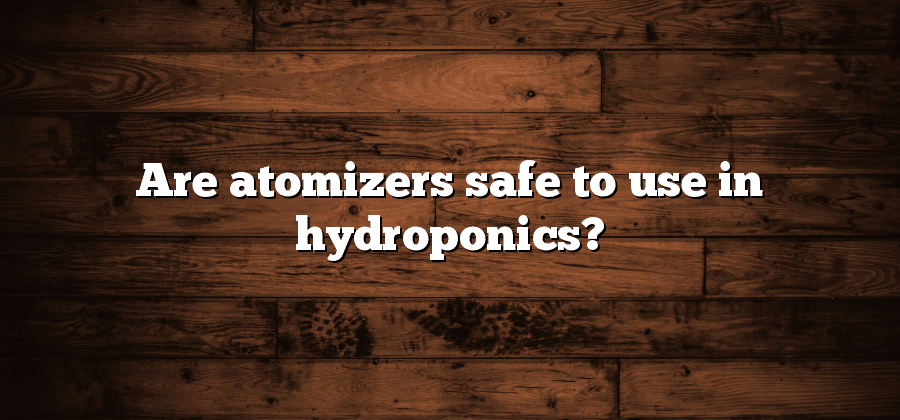Atomizer Function in Hydroponics
Hydroponics, the method of growing plants without soil, has gained popularity in recent years. Atomizers play a crucial role in this innovative gardening technique, serving as an essential component in hydroponic systems. By breaking down liquid nutrients into fine droplets, atomizers ensure optimal delivery to the plant roots. This allows for better absorption and utilization of nutrients, leading to increased plant growth and productivity.
Atomizers in hydroponics are responsible for creating a fine mist or fog of nutrient solutions, which is then evenly distributed over the plant roots. This ensures that every root receives its fair share of nutrients, avoiding the uneven distribution that can occur with other methods. Furthermore, atomizers function by creating a humid environment, which can be especially beneficial in arid regions or during periods of low humidity. This helps to combat moisture stress and promotes healthier plant development. Overall, the use of atomizers in hydroponics enhances nutrient efficiency, providing plants with a controlled and optimized growing environment. To fully understand the functioning of atomizers in hydroponics and to explore different types and their benefits, let’s dive deeper into this topic.
Atomizer Types for Hydroponics
An essential component of hydroponic systems, atomizers play a crucial role in creating a fine mist of nutrient solution for the plants. This mist is then absorbed by the plant roots, providing them with the necessary nutrients for growth. When it comes to atomizer types for hydroponics, there is a wide range of options available in the market. Each type has its own unique features and advantages that cater to different hydroponic setups and plant requirements.
One of the most popular types of atomizers used in hydroponics is the ultrasonic atomizer. Utilizing high-frequency sound waves, ultrasonic atomizers create a fine mist by breaking down the nutrient solution into tiny droplets. These atomizers are known for their efficiency and ability to produce a consistent mist, making them ideal for large-scale hydroponic operations. Their compact size and low energy consumption are additional benefits that make them a preferred choice among hydroponic growers.
Intrigued by the various types of atomizers available for hydroponics? Well, in the rest of this article, we will explore some other atomizer types that can enhance your hydroponic system. From nebulizing atomizers to high-pressure foggers, we will delve into their unique features and discuss their suitability for different plant varieties. So, without further ado, let us dive deeper into the world of atomizers in hydroponics and uncover the benefits and risks associated with these essential components.
Benefits of Atomizers in Hydroponics
Hydroponics, an innovative method of growing plants without soil, has gained popularity in recent years. Atomizers play a crucial role in this technique, offering several benefits to hydroponic growers. Atomizers, also known as foggers or misters, are devices that break down liquid into fine droplets, creating a mist that is dispersed over the plants. This mist contains a nutrient solution, providing plants with the necessary elements for healthy growth.
One significant benefit of using atomizers in hydroponics is enhanced nutrient absorption. The fine mist produced by atomizers allows nutrients to be easily absorbed by the plants’ roots. This efficient absorption promotes faster growth and increased yields. Additionally, atomizers help maintain optimal moisture levels in hydroponic systems, preventing under or over-watering. This precise control over moisture improves nutrient uptake and reduces the risk of nutrient deficiencies or root diseases.
With these compelling advantages, it is clear why atomizers are an invaluable tool in hydroponic cultivation. However, it is important to weigh the potential risks associated with their use. Before integrating atomizers into a hydroponic system, growers need to carefully consider hygiene considerations to ensure the overall success of their ventures.
Potential Risks of Atomizers in Hydroponics
Atomizers in hydroponics offer numerous benefits for plant growth and nutrient distribution. However, it is essential to be aware of the potential risks they may pose in this system. One risk that arises is the formation of water droplets that are too large, which can lead to uneven distribution of nutrients and hinder the absorption process.
Another risk is the possibility of excessive moisture buildup, which creates an ideal environment for the growth of pathogens and fungi. This can result in diseases that can quickly spread among plants, affecting the entire hydroponic setup. Proper ventilation and monitoring are crucial to prevent such risks from occurring.
By understanding and addressing the potential risks associated with atomizers in hydroponics, growers can ensure the optimal functioning of their system. Implementing sound hygiene practices and regularly checking the atomizers’ performance can greatly minimize the chances of encountering these risks. It is imperative to maintain a clean and well-maintained system to safeguard plant health and maximize yield potential.
Hygiene Considerations for Atomizers in Hydroponics
When using atomizers in hydroponics, it is crucial to consider hygiene to prevent the spread of disease and maintain optimal plant health. Proper hygiene practices can minimize the risk of contamination and ensure the success of the hydroponic system. Maintaining cleanliness in all aspects of hydroponic cultivation, including the atomizer, is essential for preventing the growth and spread of pathogens.
One important hygiene consideration for atomizers is regular cleaning and disinfection. Atomizers can become a breeding ground for bacteria, fungi, and other microorganisms if not properly maintained. As these microorganisms can negatively impact plant health, it is important to clean atomizers regularly to remove any build-up of debris or contaminants. Thorough cleaning should be done using appropriate disinfectants to eliminate any potential pathogens. By implementing proper cleaning and disinfection protocols, growers can significantly reduce the risk of disease and ensure the consistent performance of atomizers in hydroponics systems.
In the following sections, we will delve deeper into the various hygiene considerations that growers must keep in mind when using atomizers in hydroponics. We will explore specific cleaning methods, disinfection techniques, and other best practices to maintain a hygienic environment for hydroponic cultivation. By prioritizing hygiene, growers can ensure the health and productivity of their plants, ultimately leading to successful hydroponic cultivation.






